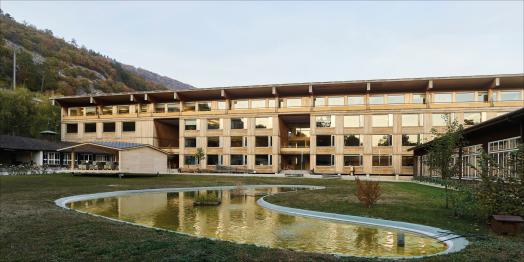Heavy duty timber bridges
08. Apr 2022
Infrastructure construction is one of the largest CO₂ emitters in Switzerland. Through the increased use of timber, it could contribute to decarbonization. On Monday 09 May, a post-tensioned and TS3-connected box girder element for heavy-duty bridges will be inaugurated at the Bern University of Applied Sciences. We cordially invite you to the inauguration.
The motion "Research and innovation of timber as a material for use in infrastructure construction as a decarbonization contribution" was adopted in the Council of States and the National Council(Read more).
The task now is to replace reinforced concrete with CO₂-storing materials such as timber in infrastructure construction. To this end, the Bern University of Applied Sciences, together with TS3 and other business partners, has developed a research strategy and built a prototype bridge element. The module will be inaugurated as part of the international bridge conference ICTB:
Inauguration heavy duty timber bridge module
Place: Bern University of Applied Sciences, Solothurnstrasse 102, Biel/Bienne
Registration and more information can be found here .
Note : The inauguration will take place during the ICTB event. There are still free places. You can find more information about the event here.

Timber in infrastructure construction
With annual CO₂ emissions of around 2.5 million tons, cement production contributes over 5 percent to national CO₂ emissions. If the Paris climate agreement is to be achieved, then the construction industry must largely abandon the use of reinforced concrete. For the construction of infrastructures, in the building sector but also in other areas such as the road sector, various solutions are already available today with materials that do not produce CO₂ during manufacture but store it. One good example is timber.

The first promising applications for timber in infrastructure construction already exist. Built noise barriers, bridges and wildlife overpasses are good examples. Further research is needed so that large bridges can be built, especially bridges in the axis of the direction of travel.

Connected with TS3 technology
The bridge elements are planned for a bridge across the axis. This allows, for example, a cantonal road over a 6-lane highway to be designed with a center support. The individual plates of the elements are flexurally rigidly connected using TS3 technology, which increases torsional stiffness and allows the individual plates to interact efficiently. To create a bridge, several elements are lined up, connected with TS3 technology and then prestressed.
The bridge elements show exemplary the drillings for the tensioning cables. Additional tension cables are inserted in the field area in the lower flange and in the area of the center support in the upper flange. The simulations for the bridge transverse to the axis were modeled with prestressing cables without bond. How to bond the prestressing cables to the timber is currently being researched. The elements are therefore to be understood as a working model that does not show the final solutions. The elements are intended to create the possibility of trying out new solutions in the ongoing research project.



